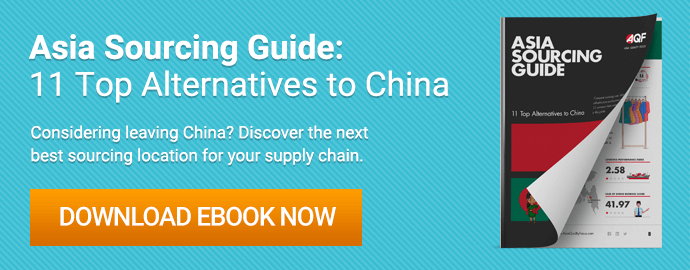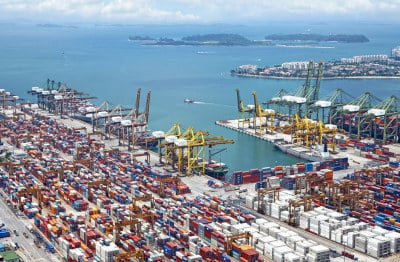 If you’re considering moving production out of China, you’re not alone.
If you’re considering moving production out of China, you’re not alone.
With the trade wars raging and Chinese labor prices on the rise, more than 40 percent of American companies have either already shifted production to different locations, or are considering it.
But if your shipping experience is primarily from China, starting again with new countries can be a challenge. How do you make sure you are getting the best pricing when making this move?
Here are three strategies:
1. Understand the details of your export country
To make sure you are getting the best freight pricing when shifting your sourcing, first dive into the details of the location you’ve chosen.
Go deep on geography
The location of your production relative to your destination can affect pricing significantly.
If you’ve shipped from China, you know this: shipping to the west coast of the US is cheaper than shipping to the east coast. Additionally, the further inland you go, at either origin or destination, the more prices rise.
So consider the routes that your goods will need to travel from your new origin countries when planning your supply chain costs. If you’re early enough in the process, you can even use this information to select the location of your destination warehouses.
Here’s an illustration: from many countries in Asia, goods typically move east over the Pacific Ocean to the west coast of the United States.
However, from India, goods can travel either east or west, depending on the port. Shipments from Chennai or Kolkata take an eastward route, which means costs to Los Angeles are lower. However, shipments from Mumbai travel westward, which means the east coast U.S. becomes a more efficient–and affordable–destination.
This chart shows the kind of pricing you might expect for a 1.5 CBM, 300-kilogram shipment with port-to-port costs: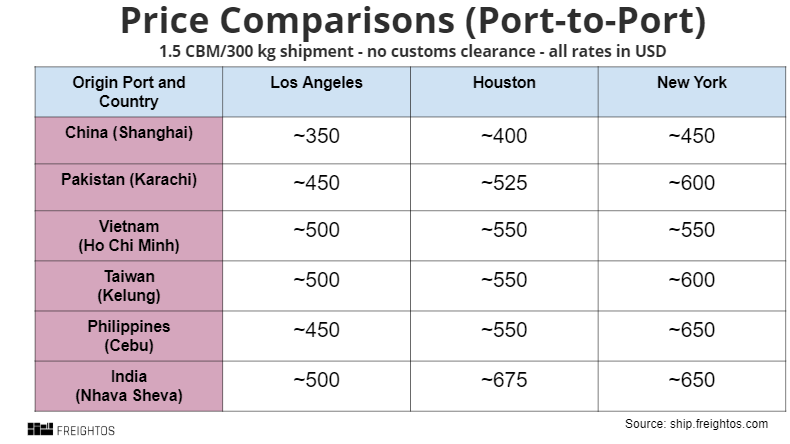
Get to know your country’s customs charges
Many people don’t realize how much duty charges can add to overall costs, but add they can.
Duty rates are set according to both the item’s HS code and its country of origin, so research both in advance and estimate your duty rates.
Research free-trade agreements and free economic zones
A free-trade agreement with the U.S. is a huge bonus–here is a list of the countries that have them.
Additionally, sourcing in free economic zones can dramatically decrease expenses. For example, in the Philippines, the government has set up a number of these zones to boost growth, which means free export from those locations.
2. Work with multiple forwarders instead of only one
If you want the best freight pricing, don’t stop at one price quote. Instead, speak to several freight forwarders or use a freight marketplace so you can find the best value.
Using one forwarder for all your shipments means being limited by the schedule, capacity and prices of the carriers they most commonly work with. Working with multiple forwarders gives you the ability to compare prices, as well as access much more carrier supply–so your inventory won’t get held up by any one carrier’s delay.
Comparing quotes also gives you a better sense of where market pricing really is. Freight forwarders often quote prices either much higher or much lower than the market rates. If you have multiple quotes, you can use them to both negotiate and understand whether you’re getting the best deal.
How to choose a forwarder
Don’t know where to start choosing a forwarder? Here are some key factors to keep in mind:
- Your particular shipping needs. Some forwarders specialize in certain types of items–or don’t provide coverage at all for others. If you’re shipping something with special restrictions, such as hazardous cargo (which can be something as benign as toys with batteries) or oversize shipments, check to make sure your forwarder can handle that.
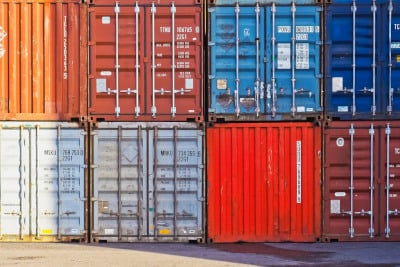
- Lane coverage. Not every forwarder ships from and to every location. This is especially important to keep in mind if you are switching or adding new production sites. (find coverage for 30+ lanes)
- Check customer reviews. One of the best ways to know if a forwarder is reliable is to ask people who’ve actually used them. Look for online reviews of the forwarders you’re considering and get honest feedback.
- Consider price–but also service. You want to get the best price. But in shipping, good service and reliability are king. After all, saving a few hundred dollars won’t help if your shipment arrives damaged, or not at all.
3. Analyze your freight quotes
If you understand what’s included in a shipping quote, you are much better equipped to find the best prices for your freight.
Get line-by-line quotes from your forwarders
The first step is to ask your forwarders for detailed quotes with line items, not just total costs. You might find that one part of your shipment is too high, or you might discover an item that is unexpectedly low–which might seem great, but could be a red flag that hidden costs will crop up later.
Here’s an example of what a price quote actually looks like: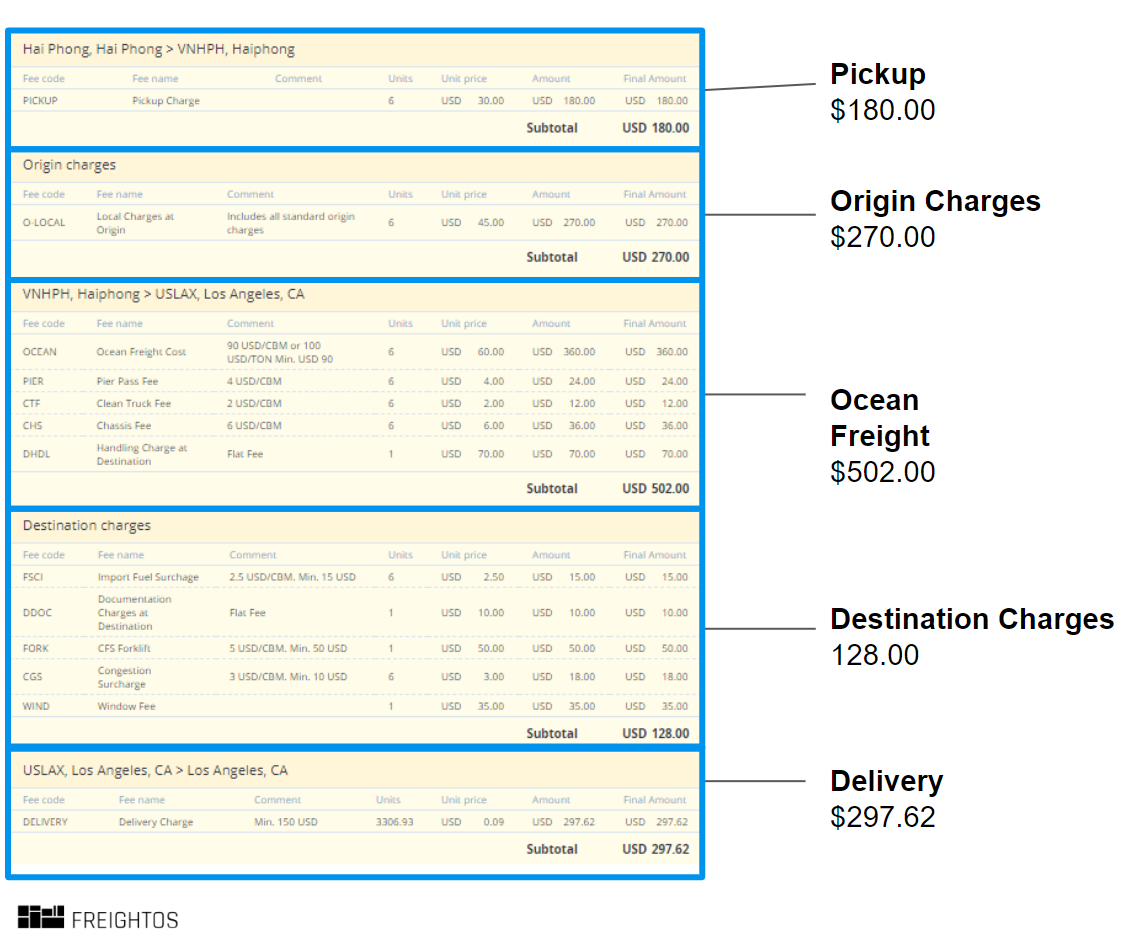
This quote is for an LCL ocean shipment and is divided according to the shipping process:
- Pickup covers the charges of moving goods from your warehouse or factory to port
- Origin charges include consolidation charges–that is, charges related to loading your goods into containers together with the goods of other importers
- Ocean freight covers the actual sea journey
- Destination charges means the costs of unloading your shipment from its container and separating it from other shippers’ goods
- Delivery refers to the costs of ground transportation to your warehouse
By noting what you’re actually paying for at each stage, you’ll be able to compare quotes more effectively.
Understand the impact of incoterms
When analyzing your freight quotes, make sure you understand exactly what service you’re paying for.
Here, incoterms, or standard terms that define responsibility for the shipment at each stage of transportation, come into play. Most freight shipments use either an Ex Works (EXW) or Free On Board (FOB) incoterm agreement with their supplier.
EXW means that you (through your forwarder) are responsible for every step of transporting your goods, from pickup at the factory all the way to delivery at your destination warehouse. FOB means the forwarder is only responsible once goods are loaded onto the ship.
That means FOB quotes are usually cheaper, since they provide less service. But that doesn’t mean that shipments using FOB will be cheaper overall. Instead, you will have to pay your supplier to transport your goods to the port. So you're simply paying your supplier instead of the forwarder for the service.
So to get the best price, compare the cost of having the supplier deliver the goods to the port and having your forwarder provide an FOB service to the cost of paying the forwarder for EXW service. Looking at the entire quote, along with all your shipping costs, shows you where your costs are coming from, so you can make an informed decision.
Conclusion
Moving production outside of China can be challenging. But a little strategy can make a big difference. Do your research and insist on getting comprehensive information from providers, and you’ll set yourself up for shipping success.
Do you have any tips about finding the right freight forwarder? Share your thoughts in the comment section below!
